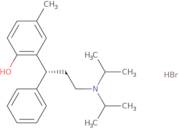
TolterodineHydrobromide
CAS: 837376-36-0
Ref. 3D-FT148292
| 25mg | To inquire | ||
| 50mg | To inquire | ||
| 100mg | To inquire | ||
| 250mg | To inquire | ||
| 500mg | To inquire |
Product Information
- 2-[3-(Diisopropylamino)-1-phenylpropyl]-4-methylphenol hydrobromide
- 2-[3-[Bis(1-Methylethyl)Amino]-1-Phenylpropyl]-4-Methylphenol Hydrobromide
- 2-{(1R)-3-[bis(1-methylethyl)amino]-1-phenylpropyl}-4-methylphenol hydrobromide
- N,N-Diisopropyl-3-(2-hydroxy-5-Methylphenyl)-3-Phenylpropylamine HBr
- N,N-Diisopropyl-3-(2-hydroxy-5-methylphenyl)-3-phenylpropanamine hydrobromide
- N,N-Diisopropyl-3-(2-hydroxy-5-methylphenyl)-3-phenylpropylamine hydrobromide
- Phenol, 2-[3-[bis(1-methylethyl)amino]-1-phenylpropyl]-4-methyl-, hydrobromide
- Phenol, 2-[3-[bis(1-methylethyl)amino]-1-phenylpropyl]-4-methyl-, hydrobromide (1:1)
- Racemic tolterodine hydrobromide
Tolterodine is a prodrug that is converted to its active form, tolterodine tartrate, by sulfonation of the diisopropylamine moiety. Tolterodine has a high affinity for the ileal and vesical muscarinic receptors and is used in the treatment of overactive bladder and urinary incontinence. The conversion of tolterodine to its active form can be inhibited by markers such as erythromycin, ketoconazole, or itraconazole. Tolterodine also has enantiomeric forms (d-tolterodine and l-tolterodine). The presence of d-tolterodine was shown to be associated with increased efficacy in patients with overactive bladder symptoms who have been treated with this drug.
Chemical properties
Technical inquiry about: 3D-FT148292 TolterodineHydrobromide
If you want to request a quotation or place an order, please instead add the desired products to your cart and then request a quotation or order from the cart. It is faster, cheaper, and you will be able to benefit from the available discounts and other advantages.





